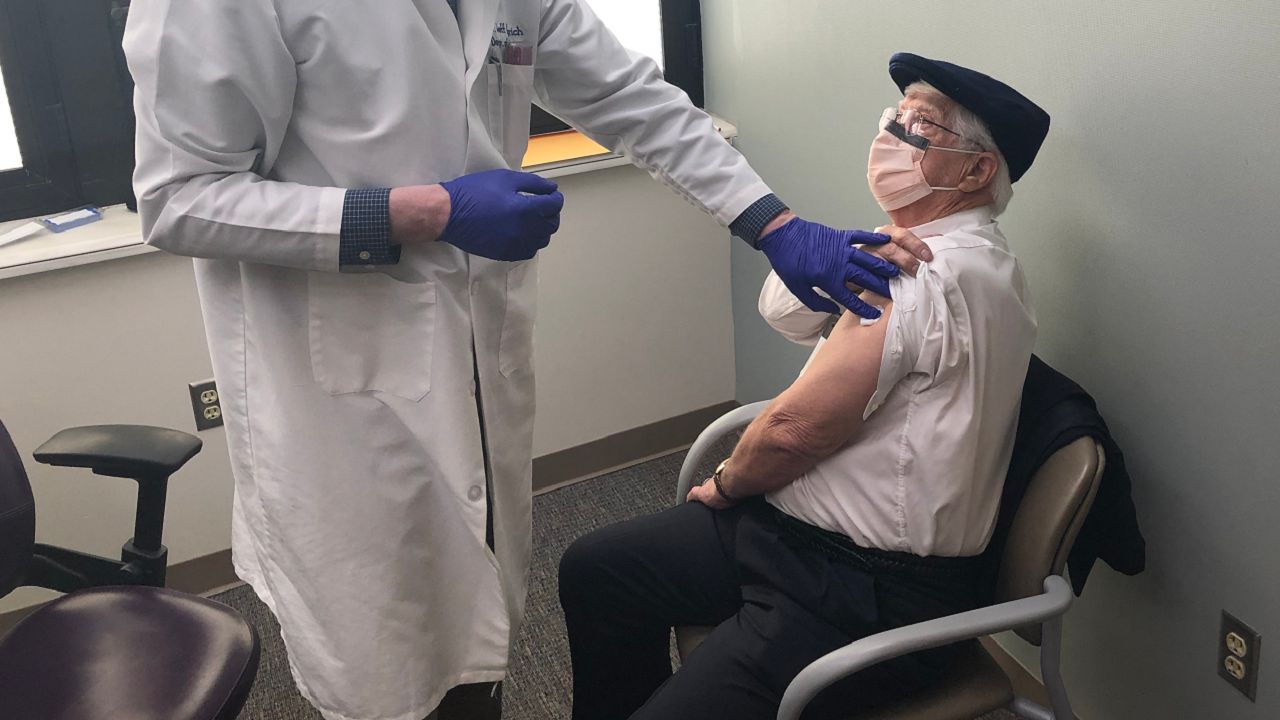FORT WORTH, Texas — Local emergency room doctor J Mack Slaughter was among the first wave of frontline healthcare workers inoculated against COVID-19.
In a video he shot of himself receiving the vaccine, thousands of viewers across social media platforms watched as a palpable sense of relief washed over the thirtysomething doctor. His voice cracked as he spoke on the emotional ware of having to keep his distance from family and friends — including his ailing mother — as he faced off with the virus at close range on a daily basis.
His side effects after the vaccine were minimal, he later told Spectrum News 1. After the first dose of the Pfizer-Biotech version, he felt soreness at the point of injection, and that dissipated almost entirely by the following day. The second dose, he said, came with the same soreness, some mild fatigue, and a “subjective fever” — he felt warm but wasn’t running a temperature.
Slaughter is also healthy and in the prime of his life. The side effects he felt, according to multiple media reports, are typical, though some people experience far more dramatic symptoms after receiving the potentially lifesaving jab.
By now, most people have read reports about allergic reactions to COVID-19 vaccines: the doctor in Boston who had to administer his EpiPen, the hospital worker in Alaska who had trouble breathing, and even debunked rumors that a few elderly patients died as a result of being inoculated. But it’s not at all surprising that allergic reactions happen. What matters most, doctors say, is the severity and the rate at which they occur.
The Moderna and Pfizer vaccines, the only ones authorized for public use in the U.S., appear to have the same types of adverse effects, called risk patterns, as those of other shots, such as the meningitis B and shingles vaccines.
So far, the vaccine has proven to be safe and effective, doctors say. The side-effects can still be scary, and a minimal risk still exists. But, doctors like Slaughter point out, every potential bad outcome of a COVID-19 vaccine should be weighed against the chance of getting sick or dying from the virus. To date, COVID-19 has claimed 2.32 million lives worldwide and more than 463,000 in the U.S. alone.
More than 40 million doses of either the Pfizer or Moderna COVID-19 vaccines have been administered in the United States, mostly to seniors and healthcare workers, since the rollout began in mid-December. With the growing number of immunizations comes a clearer picture of the negative side effects associated with the shots.
The most common adverse side effects of the COVID-19 shots are headache, fatigue, dizziness, nausea, chills, fever, and pain at the injection site, according to the CDC.
One unusual side effect of the COVID-19 vaccines is difficulty breathing, which a relatively small share of recipients have noted, though it is unclear how many of those patients fully recovered or needed further medical attention.
The side effects of the Pfizer and Moderna shots are comparable to, though slightly worse than, those of other vaccines.
For example, 24.1% of recipients of the first Moderna shot reported headaches, compared with 25% of those receiving the meningitis B vaccine, according to data from the government’s tracking website, Vaccine Adverse Event Reporting.
(The VAERS data reflects the first roughly 22 million doses of vaccine administered out of the total 40 million-plus total doses administered since the rollout began in December.)
In the clinical trial results of the two Coronavirus vaccines now being distributed across the country, many people felt intense headaches and other more severe symptoms. Pfizer, the company that makes the one Slaughter received, reported that some 13% of recipients aged 18 to 55 had a bad headache after the first dose. About 16% of those who received the Moderna vaccine in a late-stage trial had a reaction strong enough to prevent them from going about their daily routine. So far, the real-world results are consistent with those numbers.
It appears that the side effects are more pronounced with the second dose of the Pfizer vaccine, according to data taken from V-Safe. For example, 7.4% of users reported fevers after their first dose of the Pfizer vaccine compared to 25.2% who reported fever after the second dose.
"That's just your immune system working, so that I don't consider anything serious," said Dr. Paul Offit, a virologist at the Children's Hospital of Philadelphia and a member of the FDA's panel of vaccine experts who participated in a recent Zoom conference.
The VAERS platform keeps track of these "serious" adverse reactions — ones that result in hospitalization, life-threatening illness, permanent disability, congenital anomaly or disability, or death.
There were 45 reports of serious adverse reactions to the COVID-19 shots per 1 million doses administered. Non-serious adverse events were more common, with 372 reports per 1 million doses administered.
In comparison, the rate of serious adverse reactions for the meningitis B vaccine is 15 reports per 1 million doses. The rate of serious reactions for the shingles vaccine is 40 reports per 1 million doses. The shingles vaccine was given to adults older than 50, making it a better point of comparison, given that the COVID-19 vaccines have been given only to working-age and older people.
The rate of serious adverse reactions to the COVID-19 vaccines is, in context, minuscule, according to Offit.
Reporting in VAERS shows that for every 1 million doses of the Pfizer vaccine administered, only five cases of anaphylaxis occurred. For every 1 million doses of the Moderna vaccine administered, 2.8 cases of anaphylaxis occur. The risk of anaphylaxis is higher for the meningitis B and shingles vaccines.



